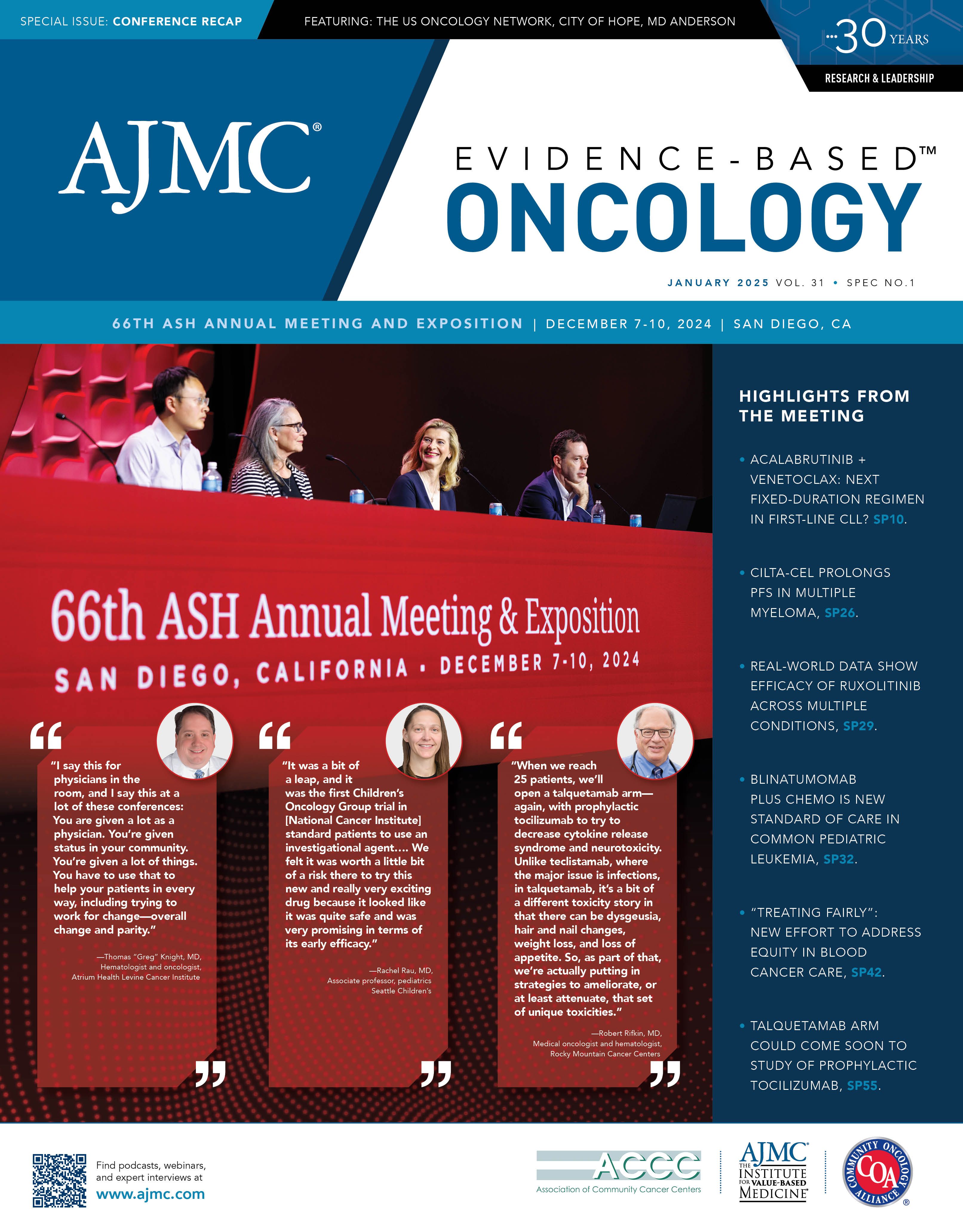- Center on Health Equity & Access
- Clinical
- Health Care Cost
- Health Care Delivery
- Insurance
- Policy
- Technology
- Value-Based Care
Adding Tafasitamab to Standard Follicular Lymphoma Regimen Boosts PFS 57%, Study Finds
The inMIND trial was the first to examine dual targeting of CD19 and CD20 in follicular lymphoma.
Adding the CD19-targeting monoclonal antibody tafastimab (Monjuvi; Incyte) to the standard combination of lenalidomide (Revlimid; Bristol Myers Squibb) and rituximab (Rituxan; Genentech/Biogen) for patients previously treated for follicular lymphoma (FL) reduced the risk of disease progression or death by 57%, according to results presented today during the late-breaking session at the 66th American Society of Hematology Annual Meeting & Exposition (ASH) in San Diego, California.1
Laurie Sehn, MD, MPH | Image credit: Photo provided by ASH

Results from the phase 3 inMIND trial (NCT04680052), which involved 548 adult patients, broke new ground in the use of immunotherapy agents, according to the study’s lead author, Laurie H. Sehn, MD, MPH, clinical professor with BC Cancer Centre for Lymphoid Cancer and The University of British Columbia, Vancouver, Canada.
“This study is actually the first to validate the approach of combining 2 monoclonal antibodies—an anti-CD19 (tafasitimab) together with an anti-CD20 (rituximab) in patients with follicular lymphoma,” Sehn said in a press briefing ahead of the session.
Dual targeting of the CD19 and CD20 proteins has been studied in other cancers, with the idea that attacking 2 proteins on the surface of B cells will boost efficacy by reducing the risk of escape mechanisms “due to antigen loss on one target alone.”2
Indeed, FL is known for increasingly shorter periods of remission following a relapse, and boosting the durability of response has been a goal for researchers. Following the success of the L-MIND trial, which led to approval of tafasitamab in relaxed/refractory (R/R) diffuse large B-cell lymphoma,3 the inMIND trial was designed to study tafasitamab alongside the standard regimen in FL and marginal zone lymphoma, with the progression-free survival (PFS) data for patients with FL reported at ASH.
The trial enrolled patients at least 18 years with FL that was low grade and slow growing; patients had to have at least 1 prior treatment, including an anti-CD20 monoclonal antibody. Patients were randomized 1:1, with arms well balanced by age, prior lines of therapy, time since last therapy, level of tumor burden, and likelihood of relapse based on a prognostic score specific to FL. According to the data Sehn presented, 45% of the patients had received at least 2 prior lines of therapy.
All patients received standard dosing of lenalidomide and rituximab for up to 12 cycles of 28 days. Patients received either tafasitamab (n = 273) or placebo (n = 275) intravenously at a dose of 12 mg/kg on days 1, 8, 15, and 22 for the first 3 cycles and days 1 and 15 for cycles 4 through 12.
Results were as follows:
- The median age of participants was 64 years, with 55% male, and 79% deemed intermediate or high risk based on FL-specific prognostic criteria; 83% had a high tumor burden
- At data cutoff, patients in the tafasitamab arm had received a median of 12 cycles of treatment, and those in the placebo arm had 11 cycles; 81% and 84%, respectively, had stopped treatment, primarily due to completion of treatment (54% vs 43%) or disease progression (11% vs 31%)
- With a median follow-up of 14.1 months, adding tafasitamab to lenalidomide and rituximab reduced the risk of progression, relapse, or death by 57% compared with placebo, with the median investigator-assessed PFS 22.4 months vs 13.9 months (HR, 0.43; 95% CI, 0.32-0.58, P < .0001)
- This benefit was confirmed by an independent review committee, which found the PFS not reached for tafasitamab and 16 months with placebo (HR, 0.41; 95% CI, 0.29-0.56; P < .0001)
- Benefits were consistent across all subgroups, and Sehn noted the particular benefit seen with tafasitamab among patientswho had received at least 2 prior lines of therapy (59%) and among those previously refractory to an anti-CD20 therapy (56%)
- Benefits were consistent among those who had seen disease progression within the past 24 months, with PFS with tafasitamab improving 57% over placebo; for those who had not seen disease progression, PFS benefit was 55% over placebo
- Sehn highlighted improvements in the duration of response rate favoring tafasitamab, with a median of 21.2 months vs 13.6 months (HR, 0.47; 95% CI, 0.33-0.68; P < .0001), as well as the overall response rate, 83.5% vs 72.4%
- Overall survival data were immature but favored tafasitamab (HR, 0.59; 95% CI, 0.31-1.13)
Adverse Events
Treatment-emergent adverse events (TEAEs) were 99% in both arms, with balance between grade 3 and 4 AEs (71% vs 69%), but slightly higher for tafasitamab. The most common grade 3 or 5 AEs with tafasitamab or placebo were neutropenia (40% vs 38%), pneumonia (8% vs 5%), thrombocytopenia (6% vs 7%), decreased neutrophils (6% vs 7%), COVID-19 (6% vs 2%), and COVID-19 pneumonia (5% vs 1%).
TEAEs that caused patients to stop treatment were reported by 11% of the tafasitamab arm and 7% of the placebo arm. Fifteen patients (5.5%) died in the tafasitamab arm vs 23 patients (8.5%)n the placebo arm; this included 5 due to disease progression in the tafasitamab arm vs 17 in the placebo arm. Six patients died in each arm due to fatal AEs.
The relative safety of a regimen with tafasitamab could make it widely accessible, Sehn said. “Importantly, tafasitamab combined with lenalidomide and rituximab can be administered easily in the community, as well as academic, settings and represents a potential new standard of care for patients with relapsed/refractory follicular lymphoma.”
References
1. Sehn LH, Luminari S, Scholz CW, et al. Tafasitamab plus lenalidomide and rituximab for relapsed or refactory follicular lymphoma: results from a phase 3 study (inMIND). Presented at: 66th American Society of Hematology Annual Meeting & Exposition; December 7-10, 2024; San Diego, CA. Abstract LBA-1.
2. Yang N, Zhang C, Zhang Y, et al. CD19/CD20 dual-targeted chimeric antigen receptor-engineered natural killer cells exhibit improved cytotoxicity against acute lymphoblastic leukemia. J Transl Med. 2024;22(1):274. doi:10.1186/s12967-024-04990-6
3. Pirosa MC, Stathis A, Zucca E. Tafasitamab for the treatment of patients with diffuse large B-cell lymphoma. Hum Vaccin Immunother. 2024;20(1):2309701. doi:10.1080/21645515.2024.2309701

The Importance of Examining and Preventing Atrial Fibrillation
August 29th 2023At this year’s American Society for Preventive Cardiology Congress on CVD Prevention, Emelia J. Benjamin, MD, ScM, delivered the Honorary Fellow Award Lecture, “The Imperative to Focus on the Prevention of Atrial Fibrillation,” as the recipient of this year’s Honorary Fellow of the American Society for Preventive Cardiology award.
Listen
